Due to operating wear and tear, brake pads are one of the most commonly replaced components in the brake system. They also happen to have a significant impact on overall brake system gain as stated back in Chapter 3. Consequently, upgraded pads are one of the most common brake system modifications.
However, in this context the word upgrade must be used with great care. While your local auto supply store likely offers a combination of premium, high-performance, heavy-duty, and severe-use brake pads, there are no industry standards for what constitutes a premium, high-performance, heavy-duty, or severe-use brake pad.
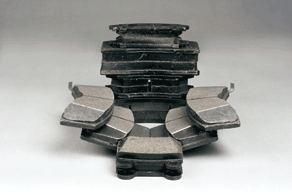
Brake pad advertising is not bound by NHTSA regulations, and unfortunately there’s only so much you can find out by looking at the parts in the box. They essentially all look the same to the untrained eye. Consequently, when picking out a brake pad for your application, it pays to do a little research first. (Randall Shafer)
The same lack of formal definition applies to semi-metallic, non-asbestos organic, ceramic, and other exotic brake pad chemistries. In all of these cases, the manufacturer is free to call the pads by whatever name they see fit. Consequently, brake pad selection is a bit of a black art.
Okay, so there’s a lot of black art involved, but that should not discourage you from trying to find the best brake pads for your vehicle. Good materials are out there, but be forewarned that finding the best pads for your application can sometimes involve some trial and error. Therefore, you need to do some homework to determine if the four pieces of friction material inside the cardboard box are suitable for your application, because the descriptions printed on the outside of the box are not very helpful at all.
Brake Pad Terminology
Before going any farther, it’s time to define the nine critical features of a typical brake pad. That’s right—in some applications, there are no less than nine brake pad design features that can impact its overall performance.
Friction Materials
The brake pad friction material is the primary wear element for the brake system. Sometimes called the friction puck, this sacrificial component is the only part of the brake pad that’s designed to make contact with the rotor, converting kinetic energy into heat. As a result, over time it’s slowly worn away until it needs replacing.
Of all the brake pad components discussed, the friction material is arguably the most critical from a high-performance perspective. There are countless varieties of friction materials available in the marketplace, and the paragraphs that follow provide you with the information you need to navigate through the overwhelming number of choices.
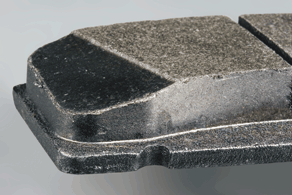
What differentiates one brake pad from another is the physical composition of its friction material. Like a fine suit, high-performance friction materials are custom-tailored to each application with a unique blend of ingredients. (Randall Shafer)
Wear Sensors
Because all friction materials eventually wear out, a wear sensor is typically fitted to each pair of brake pads to inform the driver that replacement is required. Although electronic sensors are found on a few high-end European applications, in most cases a simple steel spring is riveted to the brake pad backing plate to serve this purpose.
When the friction material wears to the point that replacement is necessary, the spring will contact the rotor, emitting a high-pitched squeal. This audible signal should not be ignored, for if the friction material wears completely away, the rotor, caliper, or both may be susceptible to permanent damage.
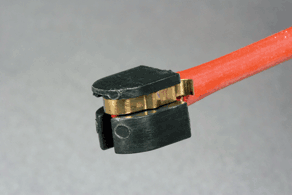
In some applications, a sensor is placed on the brake pad to alert the driver if the friction material is worn to its minimum thickness. While a spring on the backing plate can be used to emit an audible squeal under these conditions, the electronic sensor shown here informs the driver with a lamp on the instrument panel. (Randall Shafer/StopTech)
Backing Plates
Usually fabricated from simple low-carbon steel, the brake pad backing plate distributes forces from the caliper pistons to the friction material. Serrated features or through-holes in the backing plate can also serve to anchor and locate the friction material against the rotor and to transfer the brake pad friction force from the friction material to the caliper body.
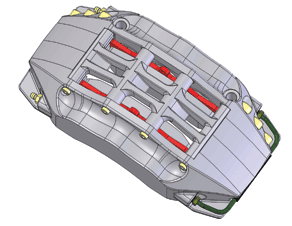
The responsibility of the backing plates (red) is to transmit the force from the caliper pistons to the friction material. They may also contain retention features such as holes or serrated edges to provide a better anchor point for the friction material. (StopTech)
Thermal Barriers
Because of their steel construction, the backing plates generally do not insulate the caliper pistons from heat very effectively. Therefore, in many racing or high-performance applications a thermal barrier is found sandwiched between the friction material and the backing plate.
The two most common forms of insulator are the ceramic puck and the woven mat. In either case, the insulating material is bonded or riveted in place during the manufacturing process and cannot be added on later.
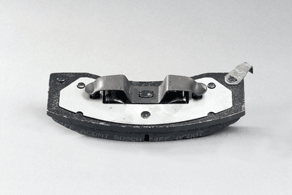
In order to reduce heat flow from the rotor to the brake fluid, a piece of insulating material can be placed between the backing plate and the caliper pistons. Stainless steel shims are the most common thermal barriers used in OEM applications and can also help to reduce certain noise frequencies. (Randall Shafer)
Adhesives
As the name implies, the brake pad adhesive bonds the friction material to the backing plate. While historically friction material has been held to backing plates with mechanical rivets, these high-temperature, high-strength glues are now the norm.
As you can image, selecting the proper adhesive is critical, considering a failure of the adhesive results in the friction material falling off of the backing plate. In this regard not all adhesives are created equal, and low-grade adhesives have been known to break down and de-bond in severe-duty applications.
Shims
Shims are usually thin stainless steel plates attached to the back side of the brake pad backing plate. They may also contain a thin layer of damping material (rubber in some cases) sandwiched between multiple stainless steel plates, but in any case these devices are used to damp out noises (squealing) that may be generated by the brake pad during use.
Note that the presence of shims does not necessarily guarantee noise-free performance, but in many applications they certainly help a great deal. A beneficial side effect is that stainless steel shims can serve as an effective thermal barrier as well. For even better thermal insulation shims can be fabricated from titanium, but the cost of this material can be prohibitive.
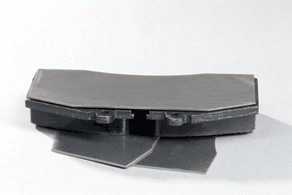
In racing applications, extreme measures are taken to keep heat out of the brake fluid. The shims shown above are fabricated from titanium, an excellent thermal insulator. Unfortunately, the cost of this material makes it impractical for production vehicles. (Randall Shafer/StopTech)
Lubricants
Lubricants can serve two purposes. The first is to allow free motion between the brake pad and its mounts, or caliper abutment plates. This prevents binding and/or residual drag during use. This is generally a good thing.
In other applications, lubricant can be applied to the backing plate directly in an attempt to provide some measure of noise suppression. Frankly speaking, this is semi-effective at best. If this technique worked as well as some people claim, you would find it in widespread use among the vehicle manufacturers. It probably doesn’t make matters worse, but don’t expect a tube of goo to prevent long-term brake noise.
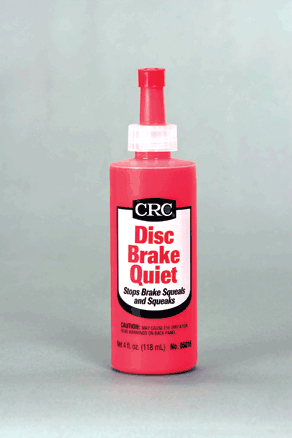
While advertised as a cure-all for brake noise, lubricants are really used to provide free motion between the backing plate and the caliper locating features. Too much lubricant can be detrimental though, as it collects dust, dirt, and debris over time. (Randall Shafer)
Chamfers
Chamfers are sometimes found ground or molded into the leading and trailing edges of the brake pad friction material itself. By angling the leading edge of the pad, there’s belief that the pad and rotor are less susceptible to certain noise frequencies. Is there an element of brake voodoo involved? Certainly, but many, many vehicles come from the factory with chamfers cut into their pads for just this reason.
The downside is that the chamfers wear down with use and may lose their effectiveness over time. In the end, every application is once again different and simply having chamfers does not guarantee noise-free operation across the board.
Noise concerns aside, some high-performance brake pad manufacturers add chamfers to reduce the initial surface area of the brake pad friction material. This step is taken to increase the rate of temperature rise when the brakes are first applied, providing a more stable coefficient of friction. Although the chamfers still wear away as the pads are used, the reduced thermal mass of the friction material can offset the reduction in chamfer area, enabling rapid temperature rise rates and consistent performance over the life of the pad.

In some applications, the leading and trailing edges of the brake pad friction material are chamfered. This is typically a countermeasure for noise, and does not have an impact on the brake pad’s performance, although in theory it contributes to shorter brake pad life. (Randall Shafer)
Slots
Slots are nothing more than vertical grooves cut into the face of the friction material. They’re typically found evenly spaced along the pad, with one or two slots being the most common. While simple in concept, they serve a variety of purposes.
First and foremost, slots allow an escape route for brake pad dust, preventing it from building up between the pad and rotor face. Second, slots allow for thermal expansion of the friction puck at elevated temperatures, which prevents stress cracks in the puck. And finally, slots can act as redundant leading edges for the puck, which can, in some cases, increase the effective coefficient of friction of the pad.
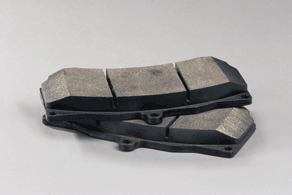
The brake pads shown above have a rectangular profile (long length, short height). Consequently, they have two vertical slots cut in the friction puck to allow for thermal expansion without cracking. (Randall Shafer/StopTech)
Coefficient of Friction
Back in Chapter 3 you learned that the brake pad’s primary role is to convert caliper clamp force into a frictional force, which opposes the rotation of the spinning rotor as defined by the following relationship:
Brake pad friction force (lb) =
caliper clamp force (lb) x
coefficient of friction (unitless)
Because most brake pads have a coefficient of friction much less than 1.0, the gain will always be less than 1:1. More precisely, the coefficient of friction value is always equal to the gain. Consequently, the friction force is always much less than the caliper clamp force.
So what is the coefficient of friction of your brake pads? Good question! While most brake pad manufacturers provide you with an approximate value over a typical temperature range, be forewarned that like a tire’s mu-slip curve, anything and everything can affect the coefficient, and defining it as a single value is impossible to do.